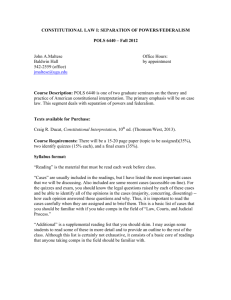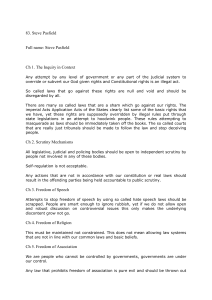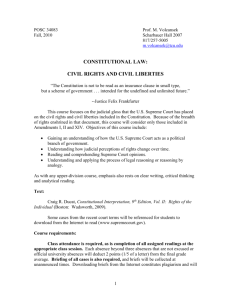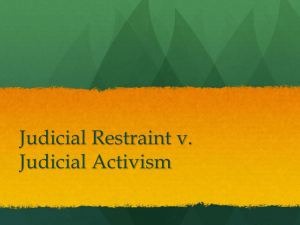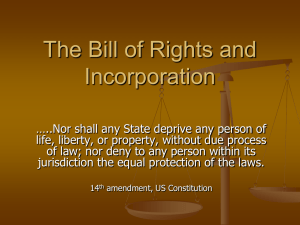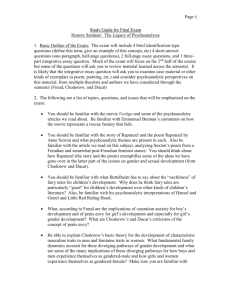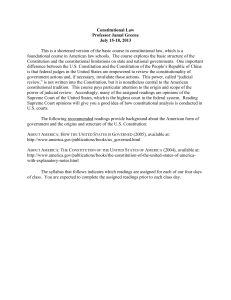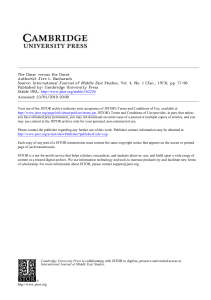POLS 4710 – “CONSTITUTIONAL LAW: RIGHTS/LIBERTIES”
advertisement
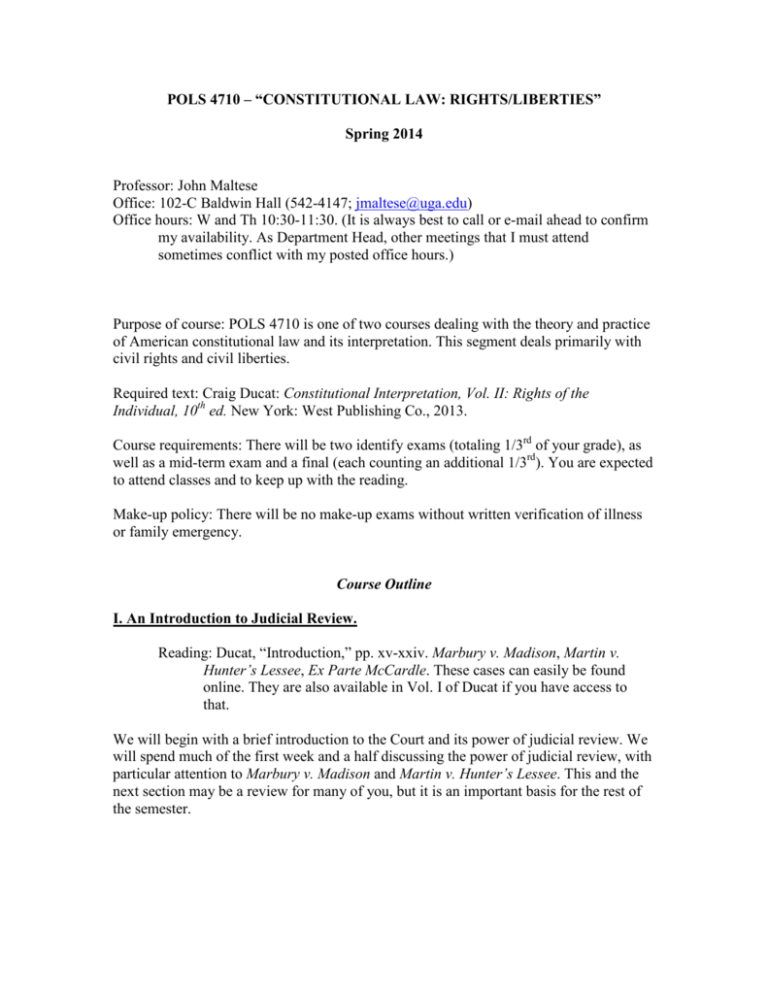
POLS 4710 – “CONSTITUTIONAL LAW: RIGHTS/LIBERTIES” Spring 2014 Professor: John Maltese Office: 102-C Baldwin Hall (542-4147; jmaltese@uga.edu) Office hours: W and Th 10:30-11:30. (It is always best to call or e-mail ahead to confirm my availability. As Department Head, other meetings that I must attend sometimes conflict with my posted office hours.) Purpose of course: POLS 4710 is one of two courses dealing with the theory and practice of American constitutional law and its interpretation. This segment deals primarily with civil rights and civil liberties. Required text: Craig Ducat: Constitutional Interpretation, Vol. II: Rights of the Individual, 10th ed. New York: West Publishing Co., 2013. Course requirements: There will be two identify exams (totaling 1/3rd of your grade), as well as a mid-term exam and a final (each counting an additional 1/3rd). You are expected to attend classes and to keep up with the reading. Make-up policy: There will be no make-up exams without written verification of illness or family emergency. Course Outline I. An Introduction to Judicial Review. Reading: Ducat, “Introduction,” pp. xv-xxiv. Marbury v. Madison, Martin v. Hunter’s Lessee, Ex Parte McCardle. These cases can easily be found online. They are also available in Vol. I of Ducat if you have access to that. We will begin with a brief introduction to the Court and its power of judicial review. We will spend much of the first week and a half discussing the power of judicial review, with particular attention to Marbury v. Madison and Martin v. Hunter’s Lessee. This and the next section may be a review for many of you, but it is an important basis for the rest of the semester. II. Modes of Constitutional Interpretation. Reading: Ducat, “Modes of Constitutional Interpretation,” essay starting on page 1343 at the end of the book. In order to determine whether an action violates the Constitution, judges must determine what the Constitution says and what it means. This is not always as easy as it might seem. In addition, judges must decide how aggressively to use their power of judicial review: whether or not to exercise judicial restraint. We will discuss these concepts, and introduce the Rational Basis Test and the Strict Scrutiny Test (two competing tests used by the Court in its exercise of judicial review). III. The Original Understanding of the Bill of Rights. Reading: Ducat, Chapter 8, section a, pp. 488-490. We will look at why the Bill of Rights was added to the Constitution and the original understanding of the scope of those rights. Barron v. Baltimore settled the issue until passage of the post-Civil War amendments to the Constitution, at least as far as the Supreme Court was concerned, but some still believed that the Bill of rights should limit the power of states as well as the power of the national government. IV. The Incorporation of the Bill of Rights. Reading: Remainder of section “a” of Chapter 8. The 14th Amendment to the Constitution (ratified in 1868) contains two clauses (the “privileges or immunities” clause and the “due process” clause) which some say were intended to “incorporate” (make binding on the states) the specific provisions of the Bill of Rights. To incorporate the First Amendment, for example, would mean that not only shall Congress make “no law respecting an establishment of religion, or prohibiting the free exercise thereof; or abridging the freedom of speech, or of the press;” etc., but neither shall any state make any such law. The Supreme Court initially rejected incorporation in the Slaughterhouse Cases (1873), but in the years that followed the process of “selective incorporation”: that, is picking and choosing some provisions of the Bill of rights to incorporate, but leaving other provisions unincorporated. We will examine arguments for and against incorporation, and also compare different approaches to incorporation, such as “Total Incorporation,” “Selective Incorporation,” and “Incorporation Plus.” V. Procedural versus Substantive Due Process. Reading: Lochner v. New York, Buck v. Bell, and West Coast Hotel v. Parrish. These cases can easily be found online. This section compares “procedural” due process (the idea that government cannot take away “life, liberty, or property” without due process of law -- that is, without fair procedure) and “substantive” due process (a concept that flourished on the Court in the early part of the 20th century, but that seemed to be repudiated by West Coast Hotel v. Parrish in 1937). VI. The Right of Privacy: Substantive Due Process Revisited? Reading: Ducat: Chapter 10. Critics charge that the Court used the old economic substantive due process cases to read rights into the constitution that could then be used to strike down laws that the majority of the Court did not like. Some critics say that is also what the Court is doing in the more recent right of privacy cases. Moreover, critics argue that some members of the Court were guilty of a double standard, because some of those who had most vocally opposed the Lochner-era cases turned around and embraced the right of privacy in cases like Griswold. Does Douglas in Griswold successfully evade that charge? VII. Freedom of Speech Reading: Ducat, Chapter 11. Despite the First Amendment’s seemingly categorical language (“Congress shall make no law…abridging the freedom of speech….”), Congress has passed (and the Supreme Court has upheld) many laws restricting some types of speech. We will examine the various tests used by the Court to judge such cases, and grapple with the definition of “speech.” VIII. Freedom of the Press Reading: Ducat, Chapter 12 (sections to be announced). We will focus on a few aspects of freedom of the press, notably censorship, prior restraint, and the problem of defining “obscenity.” IX. Freedom of Religion Reading: Ducat, Chapter 13. The First Amendment contains two religion clauses: one focusing on religious “establishment,” the other on “free exercise.” We will examine both, and analyze the various tests used by the Court to judge when these clauses have been violated. X. Equal Protection of the Laws Reading: Chapter 14, sections a and b. We will focus on racial discrimination (including the rise and fall of the “separate but equal” doctrine,” the debate over affirmative action, and whether “private” discrimination is prevented by the 14th Amendment). FINAL EXAM: Thursday, May 1, 2014, 3:30-6:30 p.m. (please verify this date and time on the official final exam schedule)


